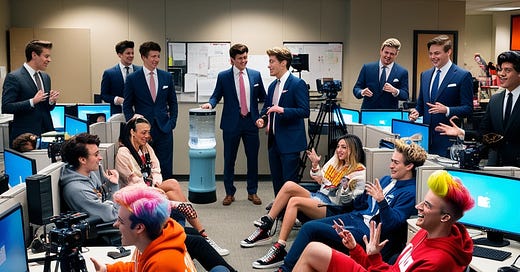What’s Holding Back Creator Ad Spend? (Hint, it Might Be The Brands)
Everyone wants scale and speed -and vetting and control
There are many commonly cited reasons why ad spending with creators hasn’t scaled as much as expected:
Fragmentation
A lack of common infrastructure
Poor measurement
Slow production cycles
But perhaps the biggest obstacle to this sector’s growth is the least obvious: the brands themselves.
That may sound counterintuitive—especially when nearly every major marketer is touting the need to shift more spending toward creators. Unilever, for instance, has committed to spending 50% of its massive multi-brand budget on YouTubers, TikTokers, and other influencers.
The rationale was perhaps best summed up by Presca Ahn, Global Investment Director, BOLD at L'Oréal.
“Our customers are consuming short-form video roughly 100 minutes a day,” she said, “and they universally hate the ad experience.” Hence the growing push for more organic brand integrations.
Ahn made these comments during Rembrand’s Control + Create event in New York on Wednesday.
However, this ramping-up effort remains a “pain point” and can feel “overwhelming” for brands like L'Oréal. Despite a long-standing mantra to "meet the customer where they are," many brands are struggling to do so.
“Creators are the cornerstone of how we think about everything,” said Ahn. “So the ability to do that in a scalable way is absolutely needed.”
That’s why companies are increasingly focused on building scalable influencer discovery, vetting, and buying processes. Still, the conservative culture of many big brands threatens to hold back that vision.
Maximize your YouTube advertising with VuePlanner. As a member of the YouTube Measurement Program for Brand Suitability and Contextual Targeting, VuePlanner enables you to buy with confidence, clarity, and precision. Using advanced technology and AI-powered optimization, VuePlanner offers custom-curated contextual collections, exclusive content strategies, and transparent reporting for measurable, impactful results. Take control of your campaign performance—partner with VuePlanner now.
____
Consider comments from several marketers at the event:
“Creators and influence are a massive opportunity for us,” said - Megan Richardson, Manager of Tech Venture & Innovation, Pepsico. “We are building out several teams focused on how best to do this, as well as launching an Influencer Center of Excellence.”
“It’s its own channel in media. It’s complementary to traditional media. You don’t have to choose one over the other.”
Jason Acker, Vice President of Media & Digital, Diageo
“We’re really trying to bring creators into the brand. We have a whole team of people doing background checks, analyzing their audiences. It’s an incredible team. We’re getting better at understanding what’s working and leveraging analytics to boost performance.”
“There are more and more opportunities to use AI to understand creators and their audiences.”
While this may be sound business, none of this sounds particularly fast. Large brands have always hesitated to fully relinquish control in the world of social media. These are organizations built around carefully crafting and protecting their brand narratives—they’re not always comfortable leaving storytelling up to outsiders.
That was evident when both PepsiCo and Diageo were asked about using generative AI for creative work. Their response - we’re using it for ideation and mock-ups, sure. But pushing a bunch of machine-made content live without going through our usual approval processes? Not just yet.
That doesn’t mean their caution is entirely misplaced. As Kelly Metz, Spark Foundry as chief investment officer told me in Cannes, maybe a great brand integration with an influencer should take some time. So does making a great TV spot.
It also raises the question: Where does this work belong? Is influencer integration a media deal or a creative one?
To that end, Razorfish has taken a novel approach by building an in-house team of reliable creators through its Creator Colab program.
“As a marketer, you have to be thinking about how your influencer programs scale and how to break through—especially since Gen Z and Gen Alpha are used to consuming massive amounts of content,” said Razorfish president Dani Mariano in a Cannes interview, as part of my ongoing series with Vueplanner on the YouTube ecosystem.
“It’s not easy for any brand to master the creator universe.”
These Razorfish creators are full-time employees skilled in content creation for social platforms. They’re selected based on their ability to produce strong brand integrations—not just follower counts.
But this raises an interesting question: Are these individuals still truly “creators”? Or are they becoming specialized creative ad executives? It’s debatable.
Similarly, Walmart has carved out a stable of creators who excel at executing commerce deals, particularly live shopping - and they have partnered with Omnicom to help accelerate this initiative.
That begs the question - how can you make sure you have enough compelling creators who are good at commerce, without burning them or their audiences out?
“I believe strongly in choice,” said Khurrum Malik, VP of Marketing at Walmart Connect during a live taping on Next in Media in Cannes. “We honor a creator’s desire to work with multiple brands—and we honor the brand’s choice to work exclusively with certain creators. The goal is to make that match happen effectively.”
“Some creators may say, ‘That’s enough.’ And sometimes, brands can oversaturate a single creator. That’s when it’s time to pull back and try something new.”
Megan Pagliuca, Chief Product Officer at Omnicom Media Group added:
“We’re increasingly treating influencer marketing like a programmatic, always-on channel. We’re encouraged by a new crop of tools and middlemen that help with discovery, workflow, and activation.”
“We even have an AI tool that provides creators with more information about brands for ideation. The entire process has become much more programmatic.”
That’s definitely the idea. Sounds great - as long as the lawyers don’t say no.






Thanks Thomas!
great article—strongly agree